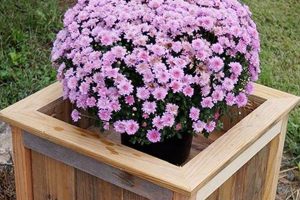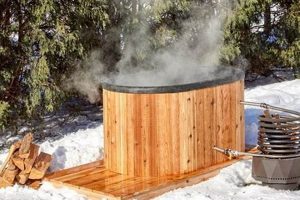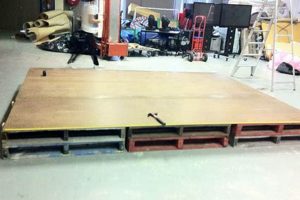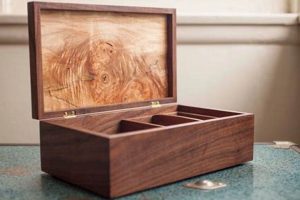A handcrafted representation of the birth of Jesus, typically constructed from wood, offers a personalized and often cost-effective approach to Christmas dcor. These handmade recreations vary widely in design, from simple, minimalist interpretations to elaborate, multi-figured displays. For instance, individuals may choose to use reclaimed wood for a rustic aesthetic or employ intricate carving techniques for a more refined appearance.
Creating such a display fosters a sense of personal investment and creative expression during the holiday season. The process often involves family participation, resulting in a cherished heirloom passed down through generations. Historically, nativity scenes have served as visual aids for religious instruction and cultural celebration, connecting individuals to a long-standing tradition. A handcrafted version amplifies this connection through the act of creation itself.
The following sections will explore design considerations, material selection, construction techniques, and finishing options for producing unique and meaningful Christmas decorations. The objective is to provide a comprehensive guide for those interested in pursuing this engaging and rewarding crafting project.
Crafting Excellence
Attention to detail and careful planning are essential for creating a lasting and aesthetically pleasing wooden nativity scene. The following guidelines provide insights into achieving a high-quality finished product.
Tip 1: Plan the Design Meticulously: Before commencing construction, create a detailed sketch or blueprint. This should include precise measurements for each component, ensuring accurate proportions and overall visual harmony. Consider the desired scale of the figures and the stable to ensure they complement each other.
Tip 2: Select Appropriate Wood Species: The choice of wood impacts both the appearance and longevity of the project. Softer woods, such as pine, are easier to carve but may be less durable. Hardwoods, like oak or maple, offer greater strength and resistance to wear, but require more advanced woodworking skills. Consider the grain pattern and color of the wood to enhance the aesthetic appeal.
Tip 3: Utilize Precision Cutting Techniques: Accurate cuts are critical for achieving clean lines and tight joints. Employ a miter saw or table saw for straight cuts and a band saw or scroll saw for curved elements. Ensure all cuts are square and smooth to facilitate proper assembly.
Tip 4: Employ Secure Joinery Methods: Select joinery techniques that provide robust and lasting connections. Options include mortise and tenon joints, dowel joints, or biscuit joints. Apply wood glue liberally and clamp the pieces securely until the adhesive has fully cured.
Tip 5: Carve with Sharp Tools and Precision: If carving is involved, utilize sharp carving tools to minimize splintering and ensure clean, defined features. Practice on scrap wood to hone carving techniques before working on the final pieces. Consider using templates or reference images to guide the carving process.
Tip 6: Implement a Thoughtful Finishing Strategy: The finishing process protects the wood and enhances its natural beauty. Sand all surfaces smooth before applying a finish. Consider using a stain to enhance the wood grain or a clear coat to protect the natural color. Apply multiple thin coats for a durable and even finish.
Tip 7: Accessorize Judiciously: Incorporate supplementary elements, such as moss, straw, or miniature figurines, to enrich the scene. However, avoid overcrowding the display, as this can detract from the overall aesthetic. Choose accessories that complement the design and enhance the narrative.
Adhering to these recommendations will contribute to the creation of a visually appealing and structurally sound holiday decoration. The commitment to quality craftsmanship will ensure the nativity scene endures for years to come.
The subsequent section will delve into variations and creative interpretations of these constructions, showcasing the versatility of wood as a medium for holiday expression.
1. Design Complexity
The design complexity of a handcrafted wooden nativity scene directly influences the resources, time, and skill level required for its creation. Varying levels of intricacy dictate the scope of the project and impact the final aesthetic outcome.
- Number of Figures and Details
A fundamental aspect of design complexity is the number of figures included in the scene (e.g., Mary, Joseph, Jesus, shepherds, wise men, animals). Each figure requires individual design and construction. Moreover, the level of detail applied to each figure, such as facial features, clothing folds, and intricate carvings, significantly contributes to the overall complexity. A simple nativity might feature only the Holy Family with minimal detail, whereas a more complex design may include numerous characters and ornate embellishments.
- Architectural Elements of the Stable
The design of the stable or shelter housing the figures is another key determinant of complexity. A basic structure might consist of a simple wooden box, while a more elaborate stable could incorporate intricate architectural features such as arched doorways, textured walls, realistic roofing materials, and interior details like a manger or hay loft. The inclusion of these elements demands advanced woodworking skills and increased construction time.
- Dimensionality and Perspective
Design complexity also encompasses the dimensionality and perspective of the nativity scene. A simple flat or silhouette design is less complex than a three-dimensional display with realistic depth and spatial relationships. Creating a scene with proper perspective and scaling of figures relative to the stable and other elements requires careful planning and execution. This aspect involves considerations of proportion, angles, and visual balance.
- Use of Moving Parts or Lighting
The integration of moving parts or lighting elevates the complexity significantly. Incorporating mechanisms to animate figures or illuminate the scene adds an engineering dimension to the project. This may involve designing and constructing simple levers, gears, or electrical circuits. Such additions necessitate specialized knowledge and skills beyond basic woodworking.
Ultimately, the chosen design complexity should align with the crafter’s skills, available time, and desired aesthetic. A well-executed simple design can be just as visually appealing and meaningful as a more intricate and elaborate creation, serving as a testament to personal expression within this traditional craft.
2. Wood Selection
Wood selection profoundly influences the aesthetic appeal, durability, and structural integrity of a handcrafted wooden nativity scene. The choice of wood directly impacts the ease of construction, the longevity of the finished product, and the overall visual impact of the scene. For instance, using softwoods such as pine allows for simpler carving and shaping, suitable for beginners or those seeking a rustic aesthetic. However, pine is more prone to dents and scratches, potentially reducing the scene’s lifespan. Conversely, hardwoods like oak or maple offer superior durability and a refined appearance. These woods resist wear and tear, ensuring the nativity scene remains intact for generations. The increased density and hardness, however, necessitate more advanced woodworking tools and techniques.
Consideration must also be given to the wood’s grain pattern and color. A consistent grain pattern contributes to a uniform appearance, while a more pronounced grain can add visual interest. The natural color of the wood can complement the overall design theme; lighter woods create a bright, airy feel, while darker woods evoke a sense of warmth and tradition. Reclaimed wood, with its inherent imperfections and weathered appearance, provides a unique character, often aligning with a rustic or historically inspired nativity scene. Proper seasoning of the wood is crucial to prevent warping or cracking after construction, ensuring the structural stability of the nativity scene over time. The source and sustainability of the wood are further ethical considerations, with many crafters opting for locally sourced or responsibly harvested lumber.
Therefore, the informed selection of wood represents a critical step in the creation process. It not only affects the physical properties of the nativity scene but also contributes significantly to its artistic expression and enduring value. Overlooking this component can compromise the structural soundness and long-term viability of the project, ultimately diminishing its intended purpose as a lasting symbol of the holiday season.
3. Cutting Precision
Accurate cuts are paramount to the structural integrity and visual appeal of a wooden nativity scene. Deviation from precise measurements compromises the fit and finish of the individual components, impacting the stability and aesthetic coherence of the final product. Precision cutting is not merely an aesthetic concern; it is fundamental to the successful assembly and longevity of the scene.
- Dimensional Accuracy of Figures
Each figure in the nativity scene (e.g., Mary, Joseph, shepherds) requires dimensional accuracy in its component parts. Figures with inaccurately cut pieces will not stand properly, fit together seamlessly, or maintain the intended proportions. For example, if the base of a shepherd figure is cut unevenly, the figure will be unstable and detract from the overall presentation. Precise cuts ensure that each figure conforms to the designed dimensions and contributes to a balanced and harmonious scene.
- Joint Fit and Structural Stability
Wooden nativity scenes often involve interlocking joints (e.g., mortise and tenon, lap joints) to connect various pieces. Accurate cutting is essential for these joints to fit snugly and securely. A loose or misaligned joint compromises the structural integrity of the scene, potentially leading to instability or even collapse. Precision cuts ensure that each joint engages fully, providing a robust and durable connection between the components.
- Stable Construction and Alignment
The stable, which houses the figures, requires meticulous cutting to ensure structural soundness and visual alignment. If the walls or roof of the stable are not cut squarely or to the correct dimensions, the entire structure will be skewed or unstable. Accurate cutting enables the creation of a level and properly aligned stable that provides a suitable backdrop for the nativity figures. Misalignment can compromise the aesthetic harmony of the scene and detract from its overall visual impact.
- Aesthetic Refinement and Finish Quality
Precision cutting contributes significantly to the aesthetic refinement and overall finish quality of the wooden nativity scene. Clean, accurate cuts create crisp edges and smooth transitions between components. These details enhance the visual appeal of the scene and contribute to a professional-looking finish. Conversely, rough or inaccurate cuts result in unsightly gaps, uneven surfaces, and a generally unrefined appearance. Attention to cutting precision demonstrates a commitment to quality craftsmanship and elevates the overall aesthetic value of the scene.
The emphasis on cutting precision, therefore, extends beyond mere aesthetic considerations. It directly influences the structural integrity, stability, and long-term durability of the handcrafted wooden nativity scene. Skilled craftsmanship and meticulous attention to detail in the cutting process are essential to producing a treasured piece that can be enjoyed for years to come.
4. Joinery Strength
Joinery strength represents a critical factor in the creation of durable and lasting wooden nativity scenes. The longevity and structural integrity of the scene are directly contingent upon the quality and resilience of the joinery methods employed during its construction. Proper joinery ensures the scene can withstand handling, environmental changes, and the passage of time without compromising its form or stability.
- Load-Bearing Capacity of Structural Joints
The stable component of a wooden nativity scene often requires robust joints capable of bearing the load of the roof and walls. Mortise and tenon joints, dovetail joints, or reinforced lap joints are suitable examples that provide significant strength and resistance to shear forces. Improperly executed or weak joints can lead to structural failure, causing the stable to collapse or become unstable. The choice of joint should align with the size and weight of the structure to ensure adequate load-bearing capacity.
- Resistance to Shear and Tensile Forces in Figure Construction
The figures within the nativity scene, while smaller, also necessitate strong joinery, particularly at points of connection such as arms to bodies or heads to necks. Dowel joints, pegged joints, or glued mortise and tenon joints can effectively resist the shear and tensile forces that occur during handling. Weak or poorly executed joints can cause limbs or other features to detach, diminishing the aesthetic appeal and longevity of the figures.
- Environmental Stability and Joint Integrity
Wood is susceptible to expansion and contraction due to changes in humidity and temperature. Strong joinery techniques, coupled with appropriate adhesives, can mitigate the effects of these environmental factors. Joints that are too tight or constructed with improper adhesives can crack or fail as the wood expands and contracts. Joinery methods that allow for slight movement while maintaining structural integrity are ideal for ensuring long-term stability.
- Material Selection and Joint Compatibility
The compatibility of the wood species and the chosen joinery method is crucial. For instance, hardwoods require more robust joinery techniques than softwoods due to their increased density and resistance to compression. Combining dissimilar wood species with varying expansion coefficients can also lead to joint failure over time. Careful consideration of material properties and their impact on joint performance is essential for ensuring the durability of the wooden nativity scene.
In conclusion, the long-term preservation and aesthetic appeal of a wooden nativity scene are inextricably linked to the strength and resilience of its joinery. By selecting appropriate joinery methods, employing skilled craftsmanship, and considering environmental factors, the creator ensures that the scene becomes a cherished heirloom capable of withstanding the test of time.
5. Carving Skill
The creation of a wooden nativity scene frequently necessitates carving skill, a crucial element that determines the level of detail and artistic expression achievable in the finished product. The degree to which carving is incorporated directly impacts the visual complexity and realism of the individual figures and associated components. For instance, a simple nativity scene might employ minimal carving, utilizing basic shapes to represent figures, while a more elaborate scene demands advanced carving techniques to sculpt intricate facial features, clothing folds, and realistic animal forms. The absence of adequate carving skill restricts the ability to produce a nuanced and visually compelling representation of the nativity story.
The practical significance of carving skill extends beyond mere aesthetics. It influences the perceived value and emotional impact of the nativity scene. A skillfully carved figure conveys a sense of craftsmanship and artistry, enhancing the overall sense of reverence and historical authenticity. Conversely, poorly executed carving detracts from the scene’s visual appeal and may diminish its perceived value. Examples include commercially available nativity sets that demonstrate varying degrees of carving quality, directly affecting their market price and consumer appeal. High-end nativity sets often feature meticulously carved figures with lifelike details, commanding premium prices due to the artisan’s skill and the time invested.
Therefore, the correlation between carving skill and the success of a handcrafted wooden nativity scene is undeniable. The ability to effectively carve wood not only allows for greater artistic freedom and detail but also contributes significantly to the overall aesthetic impact, perceived value, and emotional resonance of the completed project. While basic nativity scenes can be crafted with minimal carving, achieving a truly exceptional and visually compelling representation of the nativity story often requires a substantial level of proficiency in wood carving techniques. The mastering of these techniques translates directly into the tangible quality and lasting impact of the finished piece.
6. Finishing Quality
The finishing quality of a handcrafted wooden nativity scene significantly impacts its visual appeal, longevity, and perceived value. The application of appropriate finishes not only enhances the natural beauty of the wood but also provides crucial protection against environmental factors and wear.
- Protection Against Environmental Factors
Exterior finishes, such as marine-grade varnishes or penetrating oils, shield the wood from moisture, sunlight, and temperature fluctuations. These elements can cause warping, cracking, and fading, thereby compromising the structural integrity and aesthetic appearance of the nativity scene. A properly applied protective finish extends the lifespan of the piece, allowing it to endure for generations. For example, a nativity scene displayed outdoors during the Christmas season benefits from a durable finish that resists weathering and UV degradation.
- Enhancement of Aesthetic Qualities
Finishes such as stains, paints, and waxes can accentuate the natural grain of the wood, impart specific colors, and create desired textures. A well-chosen stain can deepen the wood’s natural tones, while a carefully applied coat of paint can add vibrancy and detail to the figures. The selection of appropriate finishing materials contributes significantly to the overall visual impact of the nativity scene. For instance, a distressed or antiqued finish can evoke a sense of historical authenticity, while a glossy varnish can create a more polished and refined appearance.
- Prevention of Degradation and Wear
Finishes act as a barrier against dirt, scratches, and other forms of physical damage. A properly applied finish creates a smooth, durable surface that is easy to clean and maintain. This protection is particularly important for nativity scenes that are frequently handled or displayed in high-traffic areas. For example, a clear coat of lacquer can protect the delicate features of carved figures from abrasion and staining, ensuring that they retain their original beauty over time.
- Safety and Health Considerations
The selection of finishing materials should also take into account safety and health considerations. Non-toxic, water-based finishes are preferable, especially if the nativity scene is intended for display in homes with children or pets. Solvent-based finishes can emit harmful volatile organic compounds (VOCs) and should be used with caution and proper ventilation. Prioritizing safety ensures that the nativity scene can be enjoyed without posing any health risks to its creators or viewers.
In summary, the quality of the finish applied to a handcrafted wooden nativity scene is a critical determinant of its long-term success. A thoughtfully selected and skillfully applied finish not only enhances the visual appeal of the piece but also provides essential protection against environmental damage, wear, and potential health hazards. Therefore, dedicating attention to the finishing process is a worthwhile investment that contributes significantly to the value and longevity of the cherished heirloom.
Frequently Asked Questions
The following addresses common inquiries related to creating a handcrafted wooden nativity scene. These responses aim to provide clear and concise information to assist in the successful completion of this project.
Question 1: What type of wood is best suited for carving detailed nativity figures?
Basswood and butternut are frequently recommended due to their fine grain, softness, and ease of carving. These wood types offer minimal resistance to carving tools, enabling the creation of intricate details without excessive effort. However, they may be less durable than hardwoods.
Question 2: How can one ensure structural stability when constructing a wooden stable?
Employing robust joinery techniques, such as mortise and tenon or dovetail joints, is essential. Furthermore, the use of high-quality wood glue and proper clamping during assembly significantly contributes to the stability of the structure. The dimensions and weight distribution of the stable should also be carefully considered to prevent collapse.
Question 3: What are the recommended tools for accurately cutting wood components for a nativity scene?
A table saw or miter saw is recommended for straight cuts, while a band saw or scroll saw is suitable for curved or intricate shapes. Precision measuring tools, such as a digital caliper or combination square, are crucial for ensuring accurate dimensions. Sharp blades are essential for clean and splinter-free cuts.
Question 4: How can one achieve a professional-looking finish on a wooden nativity scene?
Thorough sanding is paramount to create a smooth surface prior to applying any finish. Multiple thin coats of finish are preferable to a single thick coat, allowing for even coverage and optimal drying. The type of finish should be selected based on the desired aesthetic and the intended environment of the nativity scene. For outdoor displays, weather-resistant finishes are essential.
Question 5: What safety precautions should be taken when working with woodworking tools and materials?
Eye protection, hearing protection, and respiratory protection are essential when operating power tools or working with wood dust. Proper ventilation is crucial when applying finishes or adhesives containing volatile organic compounds (VOCs). All power tools should be used in accordance with the manufacturer’s instructions, and a clean, organized workspace is important for preventing accidents.
Question 6: How can one prevent wood from warping or cracking after the nativity scene is constructed?
Selecting properly dried and seasoned wood is the first step in preventing warping or cracking. Applying a protective finish can help to seal the wood and regulate moisture absorption. Avoid exposing the nativity scene to extreme temperature or humidity fluctuations. Storing the piece in a climate-controlled environment during off-season months can also help to maintain its structural integrity.
This information provides a foundation for understanding the core principles involved in the creation of a wooden nativity scene. Further research and experimentation are encouraged to refine personal skills and achieve desired outcomes.
The subsequent section will explore advanced techniques and creative embellishments that can enhance the aesthetic appeal and personalized character of these constructions.
DIY Wooden Nativity Scene
This exploration of the creation process has underscored the multifaceted nature of a “diy wooden nativity scene.” It has illuminated the importance of thoughtful design, material selection, precision cutting, robust joinery, skillful carving (when applicable), and protective finishing. Each stage contributes to the final aesthetic appeal, structural integrity, and lasting value of the handcrafted piece. Successfully navigating these elements ensures the creation of a meaningful and enduring representation of the nativity story.
The construction of a wooden nativity scene extends beyond a mere crafting project; it represents an engagement with tradition, a demonstration of skill, and an opportunity for creative expression. The resulting piece, born from individual effort and meticulous attention, serves not only as a seasonal decoration but also as a tangible symbol of faith and a potential family heirloom. Continued exploration and refinement of these techniques will ensure the enduring legacy of this craft.




![[DIY Guide] Easy DIY Wood Window Shutters You Can Build! The DIY Hub: Creative Crafts, Repairs & Life Hacks [DIY Guide] Easy DIY Wood Window Shutters You Can Build! | The DIY Hub: Creative Crafts, Repairs & Life Hacks](https://craftingdiycenter.com/wp-content/uploads/2025/07/th-3579-300x200.jpg)


